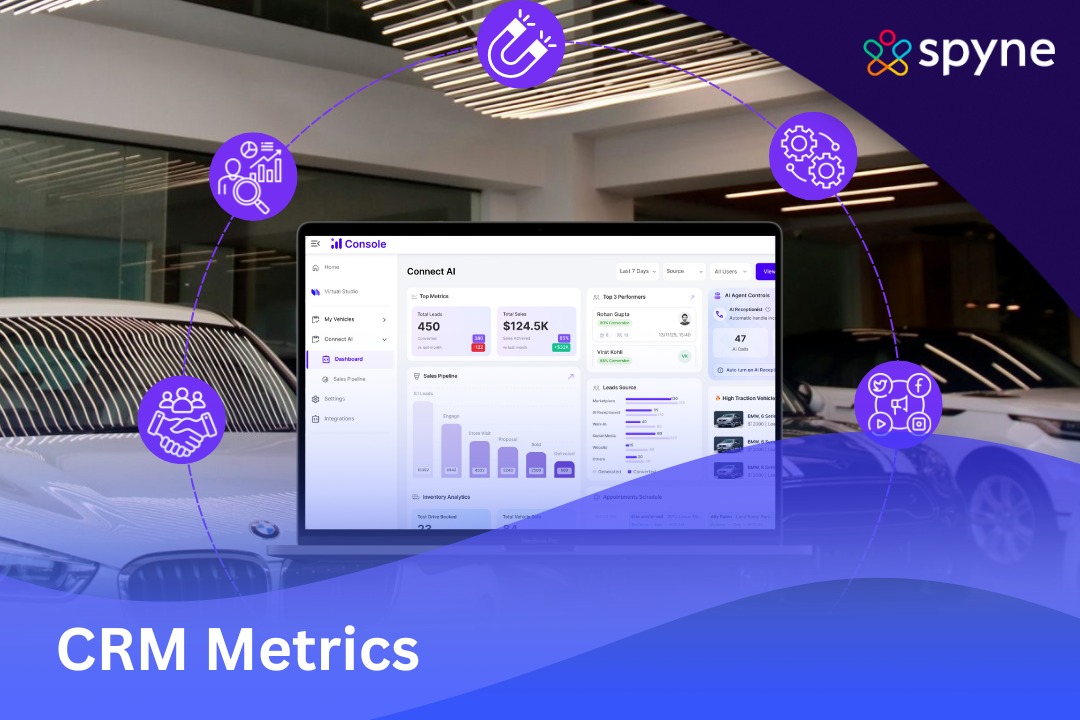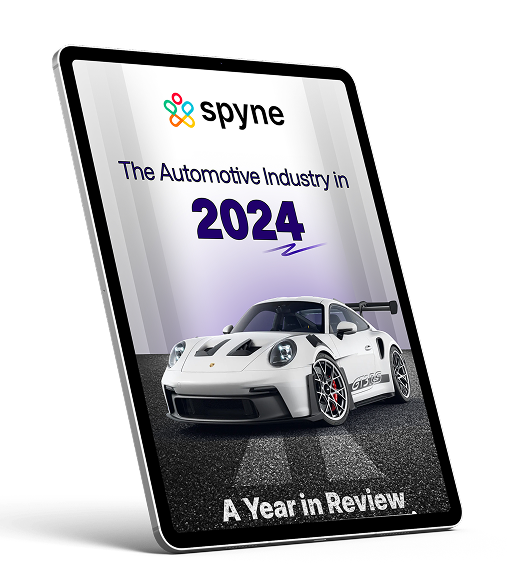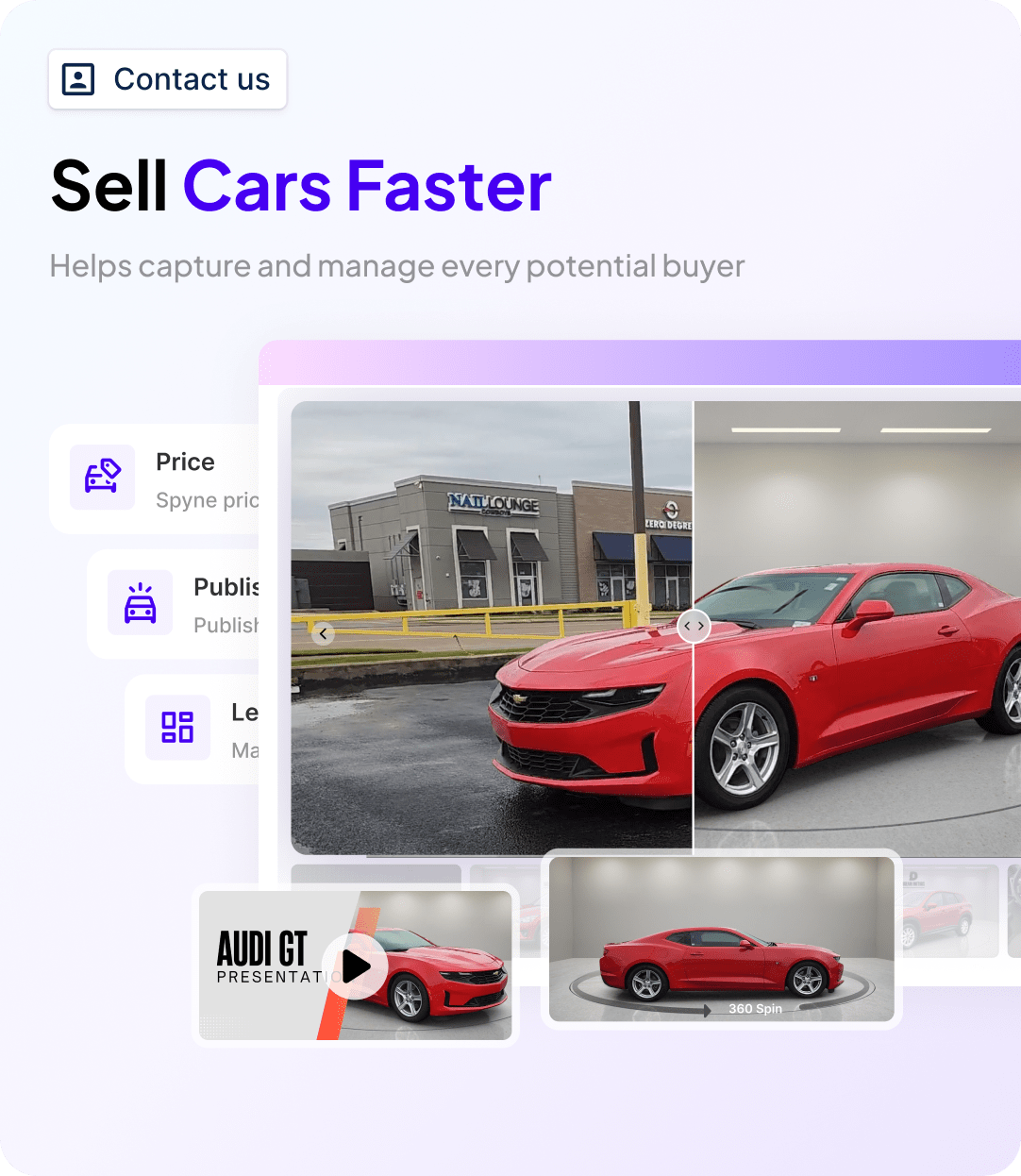Competition in the car business is not just about making great deals, but also about having important pieces of information. Tracking significant car statistics keeps dealers informed about the market trends, optimizes operations, and increases overall profitability. For small or large dealerships, the appropriate numbers inform you what is working for you and what is not working for you in the marketplace. Here we are going to learn the most important CRM metrics that the dealers need to be monitoring to enhance performance, raise sales, and provide better customer experiences.
What are Automotive CRM Metrics?
Automotive CRM metrics are key data points that assist dealerships in tracking performance, optimizing operations, and making data-driven decisions. When tracked within a CRM system, these metrics provide insight into how your team is doing in generating leads, converting prospects, and interacting with customers.
Measuring the correct metrics helps dealerships in staying aligned with business objectives, excite teams, and understand what’s going right or what needs to be changed. Effective application of CRM tools can translate into increased sales, enhanced customer experiences, and smoother follow-ups. It also provides real-time context in the course of sales, enabling dealers to adjust strategies rapidly.
In a data-supported, competitive market, CRM metrics serve as growth benchmarks. They indicate what processes work and where change is required. And they enable forecasting demand, inventory planning optimization, and discovery of customer pain points to provide more personalized service.
Top 14 Automotive CRM Metrics Every Dealer Should Track
Automotive dealerships should track a range of key CRM metrics to monitor performance and drive sales growth. These metrics cover sales, inventory, service, customer experience, and many more. Below is the list of the top 14 car dealer CRM system metrics every dealer should track.
1. Sales Conversion Rate
Why it matters: Your conversion rate will show you how well your salespeople are performing at turning leads into customers. If you’re generating plenty of leads but not closing deals, something is wrong with your process, pricing, or follow-up.
How to calculate:
(Number of Sales ÷ Number of Leads) × 100
Low conversion rate can be a sign of issues with lead quality, response time, or even staff training. Keeping an eye on this regularly allows you to view what’s going wrong and can thus be rectified.
2. Customer Acquisition Cost (CAC)
Why it matters: CAC shows how much you’re investing in acquiring each new customer. It’s an important measure for assessing the efficiency of your marketing expenditure.
How to calculate:
Total Marketing & Sales Spend ÷ Number of New Customers Acquired
If your CAC is rising but sales are not increasing proportionally, you may need to go back to review your ad spend, targeting, or messaging.
3. Gross Profit per Unit (GPU)
Why it matters: It’s one of the most important profitability metrics for your dealership. It shows how much you make on each unit after costs.
How to calculate:
Selling Price – Cost of Goods Sold (COGS)
Measuring GPU helps you to maintain healthy margins and understand what kind of cars or segments pay the best.
4. Sales per Employee
Why it matters: This metric helps to gauge the efficiency and productivity of your salespeople.
How to calculate:
Total Vehicle Sales ÷ Number of Sales Staff
It is especially useful while evaluating team performance and setting realistic benchmarks or reward systems.
5. Lead Response Time
Why it matters: The sooner you respond to a lead, the higher your chances of closing the sale. To be specific, studies show that dealerships that respond in 10 minutes or less have much higher conversion rates.
How to track: Monitor using your CRM, average response time by lead source.
Slow response time will likely lead to missed opportunities, especially in a competitive market.
6. Inventory Turnover Rate
Why it matters: Holding inventory costs money. If you have a high turn rate, you’re selling cars rapidly, which minimizes depreciation and holding expenses.
How to calculate:
Cost of Vehicles Sold ÷ Average Inventory Value
Quick turnover provides increased cash flow and enables you to refresh your inventory with current models more often.
7. Days to Sale
Why it’s important: This KPI shows how long it takes to sell a vehicle once it’s been put on the market. If cars are sitting too long, it could be an indication of price or demand issues.
How to calculate:
Date Sale – Date Vehicle Listed
Work to reduce this figure over time to improve profitability as well as reduce floor plan interest expense.
8. Reconditioning Time
Why it matters: For used car dealerships, the length of time it takes to recondition the vehicles will directly affect how quickly you can sell them.
How to calculate:
Monitor the average number of days from when the vehicle is purchased to when it is placed on the market.
Reduced reconditioning time equates to faster inventory turnover and better ROI.
9. Cost to Market
Why it matters: It includes all costs to prepare a car for sale, repairs, detailing, photography, etc. It helps determine actual profitability per unit.
How to calculate:
Add up all prep costs and divide by the sale price of the vehicle.
Tracking this helps avoid unnecessary expense and encourages smarter inventory investment decisions.
10. Gross Return on Investment (GROI)
Why it matters: GROI is one of the most detailed measures to use for estimating profitability per vehicle.
How to calculate:
(Gross Profit ÷ Vehicle Investment Cost) × 100
It’s a good indicator of whether or not a vehicle was worth the initial investment, and can help you decide which vehicle segments are most profitable.
11. Service Department Revenue
Why it matters: Your service department can be a recurring revenue stream, especially in slower months of sales. Keeping this KPI under surveillance ensures that you’re not leaving dollars on the table.
How to calculate:
Use your DMS or service software to track overall monthly income from repairs, maintenance, and parts.
Effective service operations: Similarly, well-managed operations also drive customer retention and potential for upselling.
12. Average Repair Order Value
Why it’s important: This metric CRM shows how much revenue you’re bringing in per visit. It can be used to spot areas of opportunity for upselling and guide service pricing strategy.
How to calculate:
Total Service Revenue ÷ Number of Repair Orders
Rising AROs may indicate effective upselling or migration to more expensive services.
13. Customer Retention Rate
Why it matters: Retaining customers is far less expensive than acquiring new customers. Returning customers also spend more in the long term on both services and vehicles.
How to calculate:
(Returning Customers ÷ Total Customers) × 100
Track this to gauge the success of your customer relationship and loyalty programs.
14. Net Promoter Score (NPS)
Why it matters: NPS measures the likelihood that customers will refer your dealership. It is an excellent indicator of overall brand sentiment and customer satisfaction.
How to calculate:
Use customer surveys with questions: “How likely are you to recommend us to a friend?”
Respondents receive a score of 0–10 and are categorized as:
- Promoters (9–10)
- Passives (7–8)
- Detractors (0–6)
NPS = % of Promoters – % of Detractors
An active NPS leads to increased word-of-mouth recommendations and organic expansion.
Types of CRM Metrics for Car Dealerships in 2025
CRM metrics are numbers or data that show how well your business is doing with customers. These metrics help you track sales, team performance, and how happy your customers are. Every business is different, so the metrics you focus on may change based on your goals.
To make things simple, CRM metrics are usually divided into three main types:
- Business Performance Metrics
- User Adoption Metrics
- Customer Perception Metrics
Let’s understand each of them one by one.
1. Business Performance Metrics:
How well is your business performing?
These metrics show how your sales and marketing efforts are affecting your company’s growth. They focus on things like how many sales you make, how much money you earn, and how fast your sales process is.
Examples:
- Sales Close Rate – How many leads turn into paying customers?
- Revenue – How much money your business is making.
- Customer Acquisition Cost (CAC) – How much it costs to get a new customer.
- Customer Lifetime Value (CLV) – How much a customer spends over time.
- Churn Rate – How many customers stop buying from you?
- Renewal Rate – How many customers come back or renew their contracts?
- Pipeline Speed – How quickly do deals move through your sales funnel?
- Upsell Rate – How many customers buy extra products or upgrades?
These metrics help you understand if your business is growing and making profits.
2. User Adoption Metrics
Is your team using the CRM properly?
CRM software only works if your team uses it well. These metrics show how often and how effectively your team is using the system.
Examples:
- Active Users – How many team members use the CRM daily?
- Usage Rate – How often the CRM is being used overall.
- Training Completion – How many employees finished CRM training?
- Lead Response Time – How quickly your team contacts new leads.
These numbers help you see if your team is using the CRM and following up with leads quickly.
3. Customer Perception Metrics
Are your customers happy with your business?
These metrics help you understand how customers feel about your products or services. Happy customers often come back and refer others.
Examples:
- Customer Satisfaction Score (CSAT)– A score from surveys that tells you how satisfied customers are.
- Net Promoter Score (NPS)– How likely customers are to recommend your business.
- Customer Retention Rate– How many customers stay with you over time.
- Customer Effort Score (CES)– How easy it is for customers to solve their problems.
- First Contact Resolution – How often your support team solves problems on the first try.
These metrics help you improve customer service and build long-term relationships.
Which CRM Metrics Should You Track?
You don’t need to track everything. Choose the metrics that match your goals:
- Want more sales? – Focus on close rate, upsell rate, and pipeline speed.
- Want better team performance? – Check CRM usage and lead response time.
- Want happy and loyal customers? – Track NPS, retention rate, and satisfaction scores.
The right CRM metrics can show you what’s working and what needs improvement.
Top Automotive CRM Trends That Help You Make More Money
Nowadays, it is more difficult to make a good profit selling cars. Interest rates have increased, and the buyer takes more time to make up their mind. This is why clever dealerships now depend on their automotive CRM to accomplish more than contact management. They employ it for closing more sales, doing things more quickly, and increasing profits. Let us examine the new CRM trends that will benefit your dealership.
1. Find and Close More Sales with Smarter Reports
A great CRM metrics reveals where the money is hiding. Reports assist you in acting quickly and leading the way.
- Opportunity reports indicate deals that are closing or just need a nudge. They assist your team in following up and keeping the pipeline filled.
- Simple-to-view dashboards enable you to monitor how well each salesperson or team is performing. No ambiguity. Just easy-to-see data.
- Managers have this information at their disposal to guide the team, repair vulnerable areas, and save deals on the brink of collapse.
- In short, improved reporting enables you to sell more vehicles without guessing.
2. Work Your Way with Flexible CRM Setups
Each dealership operates differently. Your CRM should enable that, not complicate it.
- Some dealers prefer having one person do it all, while others split work between internet reps, in-dealership sales, and F&I.
- A flexible CRM allows you to adopt your own process. It keeps the sale progressing regardless of who is working on it.
- It also integrates with the other tools you have, such as lead forms, marketing software, or finance tools. That way, your data remains clean and your workflow better.
- No need to adapt your style, the CRM adapts to your system, not vice versa.
3. Turn Service Visits into Sales with Smart Equity Tools
Your most valuable sales prospects might be right in your service lane and your CRM can assist you in finding them.
- Equity mining software scans your service appointments and determines who has equity in their current vehicle.
- They reveal to you who’s most likely to trade in and return, so you don’t have to do all the digging.
- These tools even score customers based on information such as “probability of purchase,” so your technicians work on the highest-quality leads first.
- That way, you can sell additional automobiles and obtain quality trade-ins—all in a normal service visit.
The Best CRM Metrics Software for Car Dealerships in 2025
Choosing the right CRM metrics software can transform your dealership’s sales, marketing, and customer service efforts. Here’s a rundown of the top automotive CRM solutions available today, highlighting their standout features and ratings.
Spyne
Spyne’s automotive CRM delivers a full suite of dealership tools, from AI-driven lead capture and multi-channel marketing automation to 24/7 virtual receptionists and in-depth analytics. Its mobile-friendly dashboard and workflow automation help teams respond faster and sell smarter. Spyne also offers seamless integration with existing dealership systems, enhancing operational efficiency.
Rating: 4.8
Podium
Podium specializes in enhancing customer interactions via messaging and review management. Its unified inbox and mobile app simplify communication, while AI-powered reviews invite you to boost your dealership’s online reputation. Podium’s tools also help improve lead conversion rates by streamlining social media engagement.
Rating: 4.3
VinSolutions
VinSolutions focuses on customizable workflows and real-time inventory visibility. With OEM-certified integrations and performance management support, it helps dealerships optimize their sales processes efficiently. Their dedicated consultants also provide personalized guidance to maximize ROI.
Rating: 4.5
Elead CRM
Elead by CDK Global, centralizes lead management and marketing automation. It tracks interactions across channels and offers customizable reporting to help dealerships monitor campaign effectiveness. Elead also supports complex customer journeys, providing tools for both sales and service departments.
Rating: 4.3
DealerSocket
DealerSocket combines customer relationship management with marketing and service tools. Its automation features and customizable dashboards support efficient sales team engagement and real-time analytics. Additionally, DealerSocket provides tools for managing customer service requests and retention campaigns.
Rating: 4.0
AutoRaptor CRM
AutoRaptor is a user-friendly web-based CRM known for lead tracking, follow-up automation, and integrated texting and emailing tools. Its flexible workflows fit a variety of dealership systems, enabling fast adoption by sales teams with minimal training.
Rating: 4.6
DealerCenter
DealerCenter’s cloud-based CRM streamlines lead and inventory management, offers digital contracting with e-signatures, and provides customizable dashboards accessible via mobile. It also supports compliance tracking and helps dealerships close deals faster through automation.
Rating: 4.6
Dealer.com
Dealer.com integrates CRM with digital marketing and website management tools. It supports lead and customer data management alongside analytics to improve engagement. Their platform also includes SEO and advertising solutions tailored specifically for automotive dealers.
Rating: 4.3
DealerOn
Primarily a website builder, DealerOn also offers CRM functionalities like lead management, communication tools, and marketing platform integration, enhancing digital advertising efforts. Their focus on user experience ensures smooth interaction between dealership websites and CRM data.
Rating: 4.4
Why Spyne’s CRM Metrics Is the Best Option for Your Car Dealerships
Spyne’s retail.AI CRM metrics is different from the rest by providing a full, AI-based platform designed just for car dealerships. If you’re a small used car lot or a multi-rooftop operation, Spyne keeps you ahead with smarter tools, quicker communication, and sales-driving automation.
1. Faster Follow-Ups, Greater Close Rates
Spyne automatically records leads and pushes them to your CRM dashboard. Your team receives real-time updates and knows precisely how to follow up based on the lead’s source. It speeds up and boosts deal closing.
2. Uninterrupted Flow of Communication Across Channels
With Spyne, you can call, text, and email customers, all from the same platform. This keeps your team streamlined and makes every customer interaction seamless and professional, regardless of the channel they prefer.
3. 24/7 Customer Interactions
Spyne’s automotive callbots and virtual agents operate even when you’re not around. They receive customer queries, schedule appointments, and respond in real-time, so your business never stops, even when your team is not around.
4. Lead Recovery That Saves Lost Opportunities
Missed a lead some time back? Spyne’s CRM will help. It automatically follows up on cold or abandoned leads, converting lost opportunities into live calls. This enables you to regain deals you would have otherwise lost.
5. Smarter Workflows for Sales Efficiency
Spyne streamlines mundane jobs such as lead allocation, follow-ups, and reminders. This allows your salespersons to spend more time selling, not on admin work. It de-stresses and increases productivity, making your operations smoother and more efficient.
6. Personalized Selling Through Deeper Insights
Spyne monitors minor customer behavior, such as ad clicks or list spend time, and converts them into intelligent insights. This enables your team to tailor every pitch to meet customers’ specific needs, making them feel heard and raising the prospect of closing the sale.
7. Seamless Integration with Existing Dealership Tools
Spyne’s CRM seamlessly integrates with your DMS, website, and inventory platforms. No data silos or manual syncing needed. Everything just happens, optimizing time and keeping all of your processes in one location.
8. Scalability That Grows With You
Whether you operate a single store or several, rooftops, Spyne CRM adjusts to your business. It’s designed to grow with you, with tools that benefit small dealerships and large companies equally, and no system change as you grow.
9. Budget-Friendly Without Sacrificing Value
Spyne provides you with all the cutting-edge automotive CRM features, AI functionalities, automation, lead recovery, and integrations at a price that won’t drain your budget. It’s built to provide best-in-class value at a price that makes sense for small and mid-size dealerships.
Conclusion
Monitoring the right CRM metrics is essential for any automotive dealership aiming to boost sales, streamline operations, and deliver standout customer experiences. From lead response time to customer retention, these data points guide smarter decisions and long-term growth. Spyne’s AI-powered CRM makes it easy to track, analyze, and act on these metrics in real time. Whether you’re managing one lot or several, Spyne helps you stay efficient, responsive, and profitable with intelligent automation and deep insights. Ready to drive better results for your dealership? Book a Free Demo with Spyne today!
Disclaimer: These services are included for comparative purposes. Spyne is not affiliated with the other tools listed; their inclusion does not constitute endorsement.
















